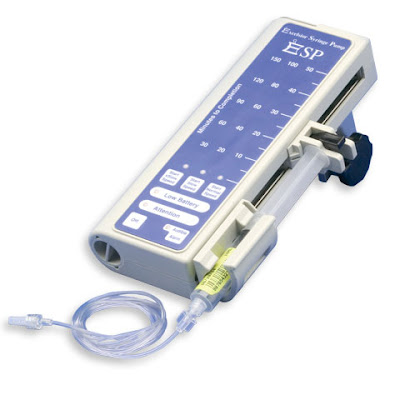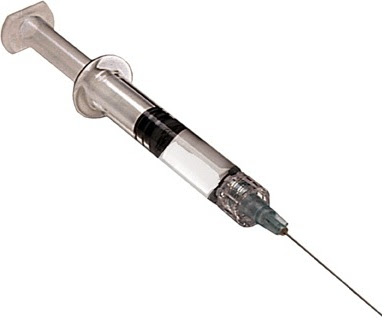Too Old To Work, Too Young To Retire demonstrates his continuing allegiance to the use of pumps for IV (IntraVenous) administration of NTG in this comment to Just So We’re Clear on the Concept . . . .
No one is going to approve giving IV NTG without a pump in place. Which just means that we have to get the pump manufacturers to develop a pump that is suitable for EMS.
Really?
No one is going to approve giving IV NTG without a pump in place.
Based on what?
Evidence that boluses of IV NTG causing adverse events?
all patients received an initial 2-mg intravenous bolus of highdose nitroglycerin, which was prepared by diluting a standard nitroglycerin solution (American Reagent Laboratories, Inc, Shirley, NY) in 5% dextrose/water to a concentration of 1 mg/mL. Subsequent 2-mg boluses of high-dose nitroglycerin were permitted every 3 to 5 minutes at the discretion of the treating emergency physician. Repeated administration of high-dose nitroglycerin was allowed for a period of up to 30 minutes, resulting in a maximum potential dose of 20 mg (2 mg every 3 minutes for 30 minutes).[1]
Everybody must have died.
Nobody would do this to patients.
Oh, the humanity!
–
–
There are plenty of problems with that kind of panicky approach to appropriately aggressive treatment.
But first –
Which just means that we have to get the pump manufacturers to develop a pump that is suitable for EMS.
We don’t have pumps that are appropriate for EMS?
–
–
–
Syringe pumps are simple, easy to use, and most medics can use them safely. They have been around for decades. Why reinvent the wheel? On the other hand, there really is no need for a pump to deliver NTG.
We are already giving NTG boluses.
Medics can give huge doses with tabs, sprays, and even by applying paste as if it were sunscreen. Maybe that is why it needs to be protected from light. 🙄
–
I don’t have any major objection to using NTG drips, but how much equipment do we need to carry? The result of carrying too much equipment is that we are more likely to make excuses for leaving the equipment in the truck.
Where is the benefit in giving NTG by pump vs. reassessing and giving another injection of NTG every 3 minutes?
The pump can allow a continuous rate to be delivered – almost always it is not enough.
The pump can make it easier to come up with excuses to ignore reassessment.
The pump can get in the way while moving patients.
The pump can add complications. Do we really need more complications in EMS?
If we are going to use pumps, we should use nice simple syringe pumps that are more dependable and have fewer pointless alarms than the pumps generally used for medications. Still, there is no necessity to use a pump before the patient is in the ambulance, or even in the ED (Emergency Department).
If we are going to use a syringe pump, why not leave out the pump and just use the syringe?
–
–
More about the research on IV bolus doses of NTG in Part II, which should be tomorrow.
–
Footnotes:
–
[1] Treatment of severe decompensated heart failure with high-dose intravenous nitroglycerin: a feasibility and outcome analysis.
Levy P, Compton S, Welch R, Delgado G, Jennett A, Penugonda N, Dunne R, Zalenski R.
Ann Emerg Med. 2007 Aug;50(2):144-52. Epub 2007 May 23.
PMID: 17509731 [PubMed – indexed for MEDLINE]
Free Full Text PDF Download from Ferne.org
.






On one hand I’ve carried pumps at the last three services I’ve worked for, some more “appropriate for EMS” than others. I really would not want to back to running vasoactives through a 60/gtt set after using a pump. Unfortunately, the “killer app” EMS infusion pumps, the IVAC/Alaris MiniMed III was discontinued last year and no replacements that offer multiple channels in that small a package are available.
On the other hand push dose pressors are well accepted in other parts of medicine, so it’s certainly not necessary to put vasoactives on a pump.
I guess you could say I’m torn on the issue. I really think we ought to have pumps on our trucks, but understand the difficulties of it.
usalsfyre,
The pumps are nice – when they work without frequent interruption of the drip to satisfy some alarm for something that does not affect patient care.
They have several problems. The most significant one is the inability to determine how much charge is on the battery. I have worked with too many medics who do not plug the pump in (and do not bring the charging cord with the pump). What do we do when the pump is dead? The hospital is going to refuse to transfer the patient with some medications not running by a pump, but some people do not think that far ahead.
Exactly.
Where is the benefit to the patient in such wide variation in doses that are appropriate for treating CHF with NTG?
The benefit is to the anxiety of those who do not understand patient care. The solution is to have the doctor, nurse, or medic learn more and worry less. Ativan is cheap.
I don’t have a problem with carrying pumps, but I don’t see why they would need to go on 911 calls. Pumps used that roughly will get beat up and they will malfunction.
We do not need to limit our patients to inadequate infusions of NTG.
.
I carry the Alaris Medsystem III in my ambulance. I use it frequently, almost daily, though mostly on critical care transfers. I will remain neutral on my personal feelings regarding said pump.
But I’m with you. Bolus NTG would be a better way to go.
CCC,
There have been many improvements in the pumps. The alarms are less sensitive, so I regularly transport patients without a single false alarm. Once they are set up, they work well.
Conversely, how long does it take to set up a bolus?
How much adjusting of the infusion rate is appropriate?
How much do we deprive patients of an appropriate dose, just to be able to claim that we have the dosing under the control of a mindless machine?
It is the way emergency medicine is moving as they find the pumps do not really improve the ability to titrate dosing, but complicate the ability to titrate NTG doses (initially).
If I am giving multiple SL (SubLingual) NTG at a time, why do so many people thing that we should use a drip rate that is much smaller than the SL dose I am giving?
If putting the patient on a drip means cutting the dose of NTG, then why should I cut the dose for a patient who has not yet begun to respond to the much higher dose?
Fanaticism consists in redoubling your efforts when you have forgotten your aim. – George Santayana.
Our aim is to improve the outcome of the patient, not to improve some superficial appearance of control over the dose.
.
I can certainly agree initial NTG infusion dosing is usually inadequate, I tend to start at 50mcg/min at titrate up to the 100mcg/min range quickly. Like within 5 minutes. I haven’t, however, had the stones to try a bolus dose of NTG. I can see where it’s been studied, the thought there…but it’s still a bias I’ve got to overcome.
I’m fairly fanatic about making sure my equipment gets charged so the battery issue only bit me once. They can be finicky, but knowing the tricks to get a good prime and keeping things plumbed so you don’t get an supply side occlusion helps. I’ve been stuck with something as clunky as a three channel Abbot Plum, so I’m fairly appreciative of the MiniMed.
We just use them with 60 dripsets, no pumps with our ntg drips
firemedic,
What about boluses of IV NTG for hypertensive CHF patients?
.